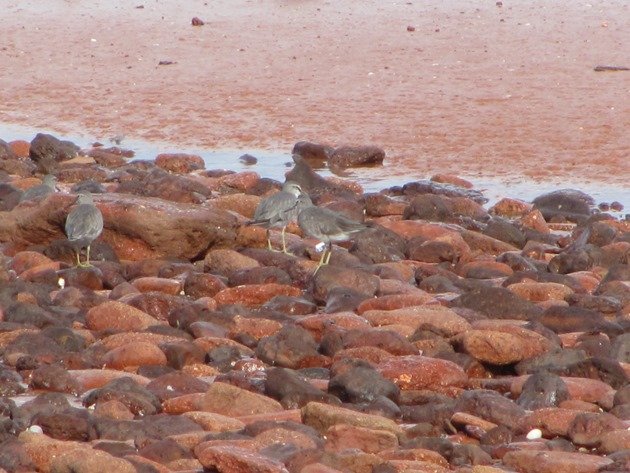
Along the coast around Broome and inland at the ephemeral lakes there are large numbers of shorebirds and often the same individuals return annually to the same location when they return from their northward migration. We regularly walk the beach in Broome between the Port and the Town Beach area and it is a particularly good beach for observing shorebirds at close range. They are in large flocks when they roost of several thousand birds, but often they will roost among their own species. Walking from the Port towards Town Beach you often find the first group of shorebirds to be the ever noisy and flighty Common Greenshank followed by the Grey-tailed Tattlers and Terek Sandpipers. These two species are renowned for preferring to lie flat on the wet sand once the tide drops rather than stand around waiting for the tide to drop. It can be over two hours before they even move and the hundreds of Red Knot have already started to feed on the mud-flats. Great Knot and Red Knot will all intermingle together and the Red Knot are easily overlooked when not in their breeding plumage when every bird appears “grey”! Curlew Sandpipers, Broad-billed Sandpipers and Greater Sand Plovers are usually stood waiting for the tide to drop. Greater Sand Plovers are the most restless of the smaller shorebirds and are constantly on the move and we observe them peck at other birds and they appear bored with the whole idea of “roosting” at high tide! Whimbrels are most likely high on the beach well away from the water’s edge and often walking ahead as you wander along the beach. The Bar-tailed Godwits prefer to be at the end of the flock and often as a solitary species. The most opportunistic of all the shorebirds is the Ruddy Turnstone as it approaches the other shorebirds and will probe around their feathers looking for parasites. The shorebirds accept their presence and appear to have an acceptance that they are doing some good!
You may remember my recent posts where we discovered a Little Tern that had been flagged in Taiwan on Cable Beach. It was only a week later that we discovered our first Terek Sandpiper that had been flagged at Torinumi in Japan. That particular Terek Sandpiper we continue to observe on a regular basis on that beach and we expect to do so until it migrates north. We then hope that it will return to see us again later in the year and continue to do so for years to come!
Now I will tell you about a Grey-tailed Tattler who is an “old friend” to us here in Broome. On 28th November 2012 I came across a large flock of shorebirds and was carefully looking through them for anything a little bit different and generally observing their activities after high tide. I suddenly observed a Grey-tailed Tattler wearing a metal band on its right tibia and a plain white flag and a blue engraved leg flag on the left tibia. I carefully noted the position of the band and flags, because this determines the location of the original banding of the shorebird. I also noted that the blue engraved leg flag read “35”, so it would be possible to identify the individual shorebird. The next challenge was to photograph the individual Grey-tailed Tattler among so many shorebirds and preferably have it standing up!
The flock of shorebirds in 2012 with Grey-tailed Tattler “35” in it!
It took some time, but eventually it was at the end of the flock as other shorebirds started to feed on the mud-flats or preen and finally I could get some sort of evidence.
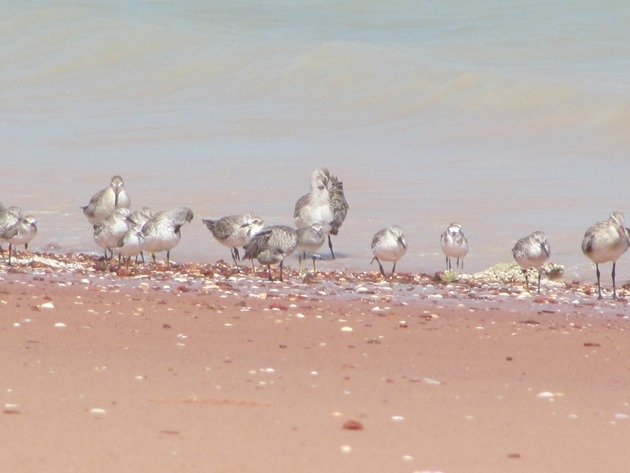
Grey-tailed Tattler “35” in 2012
I immediately contacted the banders in Taiwan and they confirmed that it was one of their birds and it had received its metal band and flags on 4th August 2012 at Kinmen Island in Taiwan and had not been observed since! Well, here it was in Broome and had travelled to spend its non-breeding season here with us. The story did not end there, because it went north and then we observed it for the first time when it returned on 23rd September 2013 and once again it stayed with us until it went north once again. Our last observation before it went north in 2014 was on 30th March and then we next observed it on 20th November 2014. It may well have been sitting down on that beach for a few months before we observed the flags! We were away in March 2015, so we don’t know how long it remained on that beach, but we observed it once again on 17th October 2015 and it continues to roost and feed in that area. It has now come to Broome for the non-breeding season of 2012, 2013, 2014 and 2015! The other interesting fact is that it has never been observed back in Taiwan and it has never been observed anywhere else in the Flyway. Nobody knows where it goes, but we do know it always returns here!
Grey-tailed Tattler “35” in 2016
The great thing about finding a shorebird flagged in Taiwan is that you can easily send them the information online and get an almost instant answer on its history. They have a website for reporting shorebirds throughout the Flyway. The first thing you do is an easy registration process and then you can log in and report your sighting.
In the report you can add your details of the species of bird and the location that you observed it. You can add the sex of the bird and the breeding plumage in this area too. You do need to note that anywhere in the southern hemisphere requires a negative sign, because the default is north.
Once you have selected your location it will zoom into that area for you.
It is then very easy to fill in the observation on a pretend bird!
It doesn’t matter if you don’t have all of the information, but you can add as much as you have and also add photographs.
Once you have “made your bird” you can submit the data and it will ask you if you want to edit anything. It will return you to the front page and if there is already information on the shorebird that you have observed it will be displayed.
This is an excellent resource and I would encourage anybody who observes a shorebird along the Flyway to add their information to the website! Maybe somebody else has observed Grey-tailed tattler “35” somewhere else since 4th August 2012, but for now its life story can be found here.
Once again I will attach a link to all the varied flag combinations that you may encounter along our Flyway.

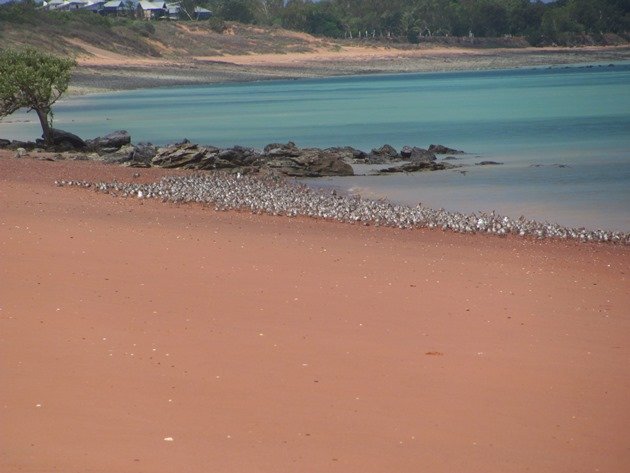
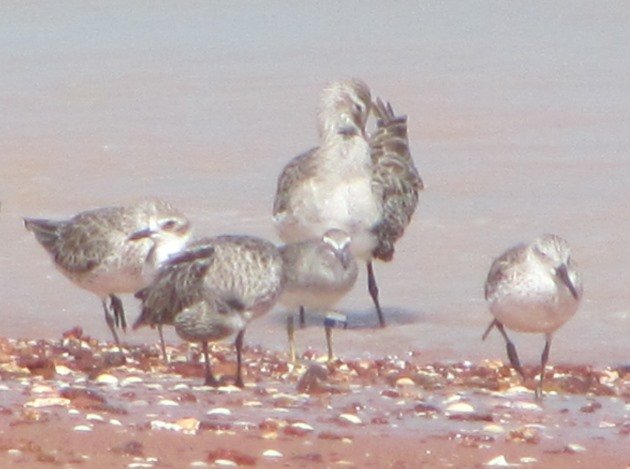

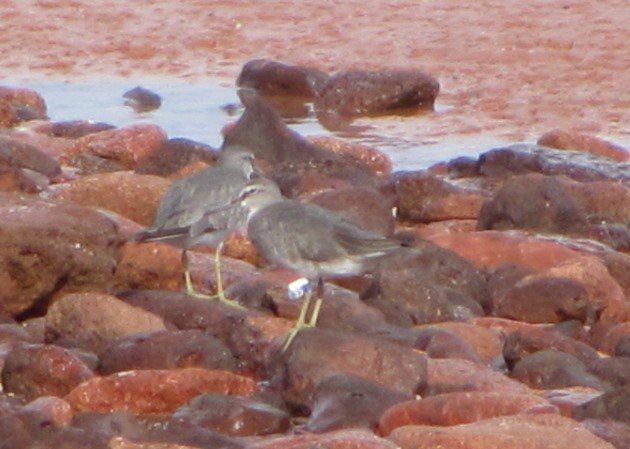

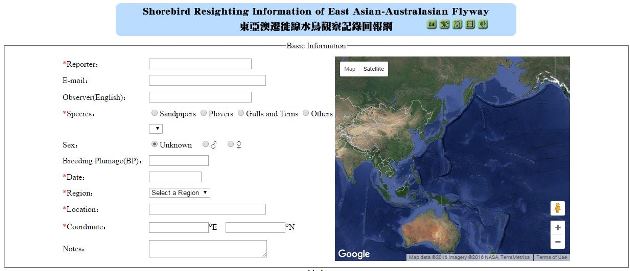
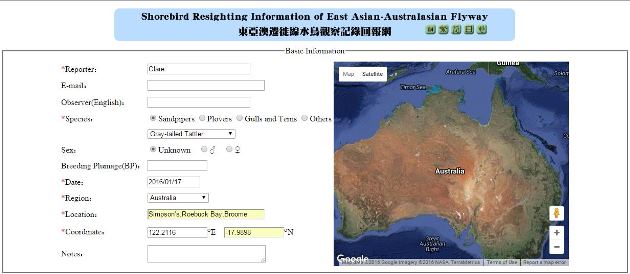
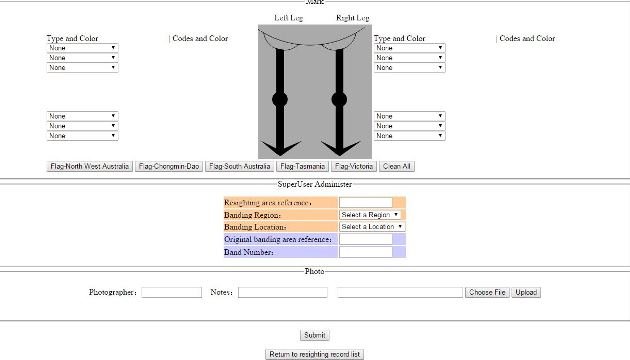











what is this: https://zukan.com/jbirds/leaf83648
The flag on your Grey-tailed Tattler is most likely from Northern Japan-Hokkaido area. Was there writing on the flag?